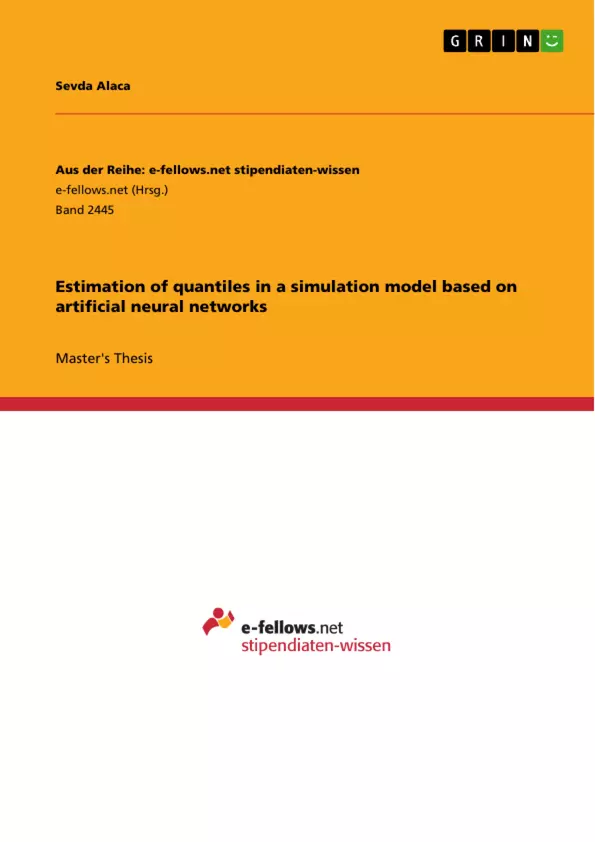This thesis deals with the development of an "alpha"-quantile estimate based on a surrogate model with the use of artificial neural
networks. Using artificial neural networks as an estimate is considered a nonparametric approach.
The estimation of a specific quantile of a data population is a widely used statistical task and a comprehensive way to discover the true relationship among variables. It can be classified as nonparametric regression, where it is one of the standard tasks. The most common selected levels for estimation are the first, second and third quartile (25, 50 and 75 percent). The quantile level is given by "alpha". A 25 percent quantile for example has 25 percent of the data distribution below the named quantile and 75 percent of the data distribution above it. Sometimes the tail regions of a population characteristic are of interest rather than the core of the distribution.
Quantile estimation is applied in many different contexts - financial economics, survival analysis and environmental modelling are
only a few of them.
Inhaltsverzeichnis (Table of Contents)
- Introduction and Overview
- Nonparametric regression
- Nonparametric quantile estimation based on surrogate models
- Introduction in Surrogate Models
- Order Statistics.
- Asymptotic distribution of a central order statistic
- A general error bound
- Neural Networks
- Introduction
- Biological neural networks.
- Historical Background.
- McCulloch-Pitts Model
- Perceptron
- Elements of an artificial neural network
- Definitions
- Sigmoid function
- Squashing function
- Artificial neuron
- Feedforward neural network with hidden layers.
- A recursive definition of multilayered feedforward neural networks
- Approximation characteristics of neural networks
- Idea
- Lemma 3 (An approximation result)
- Lemma 4
- Implementation
- The Quantile estimates
- Test Settings
- Application on Simulated Data
- Backpropagation algorithm
- Gradient descent method
- Phases of the Backpropagation algorithm
- Training and Test Phase
- Implementation
- Initialising of the weights
- Structure of the Parameters
- Partial Derivatives
- Comparison
- Discussion
Zielsetzung und Themenschwerpunkte (Objectives and Key Themes)
This Master-Thesis investigates the nonparametric estimation of quantiles in a simulation model based on artificial neural networks. The primary objective is to develop and evaluate methods for estimating quantiles when the function under consideration is computationally expensive. This research explores both order statistics and Monte Carlo approaches for quantile estimation, where the function is replaced by an estimate constructed using an artificial neural network. The thesis aims to provide a general error bound for the quantile estimate and compare the performance of the two methods through simulations.- Nonparametric quantile estimation with surrogate models
- Application of artificial neural networks for function approximation
- Development of a general error bound for the quantile estimate
- Comparison of order statistics and Monte Carlo methods for quantile estimation
- Evaluation of the methods on simulated data
Zusammenfassung der Kapitel (Chapter Summaries)
- Introduction and Overview: Introduces the research problem and provides an overview of the thesis structure. The main focus is on estimating quantiles of a function that is costly to evaluate using a surrogate model based on artificial neural networks.
- Nonparametric regression: Provides an overview of nonparametric regression techniques, which form the foundation for the quantile estimation methods investigated in the thesis.
- Nonparametric quantile estimation based on surrogate models: This chapter presents the theoretical framework for nonparametric quantile estimation using surrogate models, focusing on the order statistics and Monte Carlo approaches. The chapter also discusses the asymptotic distribution of a central order statistic and provides a general error bound for the quantile estimate.
- Neural Networks: Provides a comprehensive introduction to artificial neural networks, exploring their biological origins, historical background, and essential elements such as sigmoid functions, squashing functions, and the structure of feedforward neural networks. The chapter also examines the approximation capabilities of neural networks.
- Implementation: This chapter details the practical implementation of the quantile estimation methods, including the test settings, application on simulated data, and the backpropagation algorithm used for training the neural networks. It explores various aspects of the implementation, such as the initialising of weights and the structure of parameters.
Schlüsselwörter (Keywords)
This master-thesis focuses on nonparametric quantile estimation within the context of simulation models. It investigates the use of artificial neural networks as surrogate models for computationally expensive functions, particularly within the realm of order statistics and Monte Carlo methods. The research explores theoretical aspects like a general error bound for the quantile estimate and practical considerations through simulations. This work is relevant for fields utilizing complex models and demanding quantile estimates, such as finance, risk analysis, and machine learning.- Citation du texte
- Sevda Alaca (Auteur), 2017, Estimation of quantiles in a simulation model based on artificial neural networks, Munich, GRIN Verlag, https://www.grin.com/document/368611



